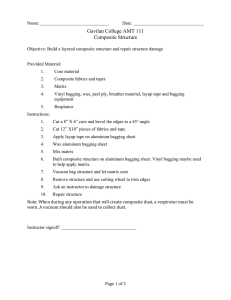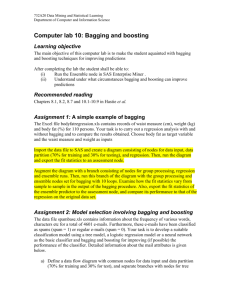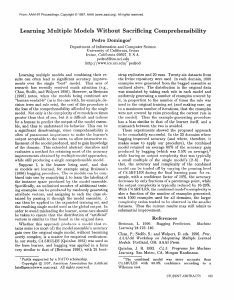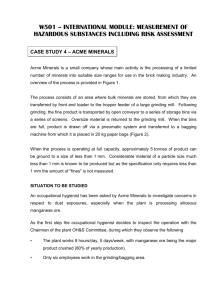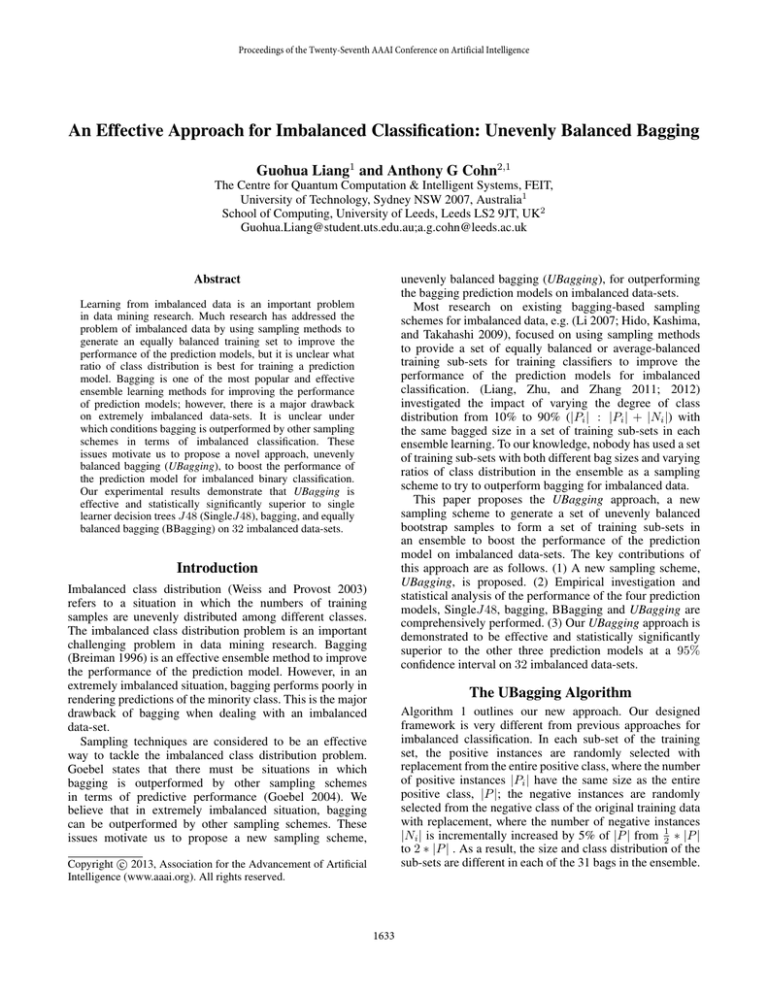
Proceedings of the Twenty-Seventh AAAI Conference on Artificial Intelligence
An Effective Approach for Imbalanced Classification: Unevenly Balanced Bagging
Guohua Liang1 and Anthony G Cohn2,1
The Centre for Quantum Computation & Intelligent Systems, FEIT,
University of Technology, Sydney NSW 2007, Australia1
School of Computing, University of Leeds, Leeds LS2 9JT, UK2
Guohua.Liang@student.uts.edu.au;a.g.cohn@leeds.ac.uk
unevenly balanced bagging (UBagging), for outperforming
the bagging prediction models on imbalanced data-sets.
Most research on existing bagging-based sampling
schemes for imbalanced data, e.g. (Li 2007; Hido, Kashima,
and Takahashi 2009), focused on using sampling methods
to provide a set of equally balanced or average-balanced
training sub-sets for training classifiers to improve the
performance of the prediction models for imbalanced
classification. (Liang, Zhu, and Zhang 2011; 2012)
investigated the impact of varying the degree of class
distribution from 10% to 90% (|Pi | : |Pi | + |Ni |) with
the same bagged size in a set of training sub-sets in each
ensemble learning. To our knowledge, nobody has used a set
of training sub-sets with both different bag sizes and varying
ratios of class distribution in the ensemble as a sampling
scheme to try to outperform bagging for imbalanced data.
This paper proposes the UBagging approach, a new
sampling scheme to generate a set of unevenly balanced
bootstrap samples to form a set of training sub-sets in
an ensemble to boost the performance of the prediction
model on imbalanced data-sets. The key contributions of
this approach are as follows. (1) A new sampling scheme,
UBagging, is proposed. (2) Empirical investigation and
statistical analysis of the performance of the four prediction
models, SingleJ48, bagging, BBagging and UBagging are
comprehensively performed. (3) Our UBagging approach is
demonstrated to be effective and statistically significantly
superior to the other three prediction models at a 95%
confidence interval on 32 imbalanced data-sets.
Abstract
Learning from imbalanced data is an important problem
in data mining research. Much research has addressed the
problem of imbalanced data by using sampling methods to
generate an equally balanced training set to improve the
performance of the prediction models, but it is unclear what
ratio of class distribution is best for training a prediction
model. Bagging is one of the most popular and effective
ensemble learning methods for improving the performance
of prediction models; however, there is a major drawback
on extremely imbalanced data-sets. It is unclear under
which conditions bagging is outperformed by other sampling
schemes in terms of imbalanced classification. These
issues motivate us to propose a novel approach, unevenly
balanced bagging (UBagging), to boost the performance of
the prediction model for imbalanced binary classification.
Our experimental results demonstrate that UBagging is
effective and statistically significantly superior to single
learner decision trees J48 (SingleJ48), bagging, and equally
balanced bagging (BBagging) on 32 imbalanced data-sets.
Introduction
Imbalanced class distribution (Weiss and Provost 2003)
refers to a situation in which the numbers of training
samples are unevenly distributed among different classes.
The imbalanced class distribution problem is an important
challenging problem in data mining research. Bagging
(Breiman 1996) is an effective ensemble method to improve
the performance of the prediction model. However, in an
extremely imbalanced situation, bagging performs poorly in
rendering predictions of the minority class. This is the major
drawback of bagging when dealing with an imbalanced
data-set.
Sampling techniques are considered to be an effective
way to tackle the imbalanced class distribution problem.
Goebel states that there must be situations in which
bagging is outperformed by other sampling schemes
in terms of predictive performance (Goebel 2004). We
believe that in extremely imbalanced situation, bagging
can be outperformed by other sampling schemes. These
issues motivate us to propose a new sampling scheme,
The UBagging Algorithm
Algorithm 1 outlines our new approach. Our designed
framework is very different from previous approaches for
imbalanced classification. In each sub-set of the training
set, the positive instances are randomly selected with
replacement from the entire positive class, where the number
of positive instances |Pi | have the same size as the entire
positive class, |P |; the negative instances are randomly
selected from the negative class of the original training data
with replacement, where the number of negative instances
|Ni | is incrementally increased by 5% of |P | from 12 ∗ |P |
to 2 ∗ |P | . As a result, the size and class distribution of the
sub-sets are different in each of the 31 bags in the ensemble.
c 2013, Association for the Advancement of Artificial
Copyright Intelligence (www.aaai.org). All rights reserved.
1633
5DQNLQJRUGHURI)YDOXH
%DJJLQJ
%%DJJLQJ
8%DJJLQJ
$YHUDJHUDQNRI)YDOXH
&RPSDULVRQRI$YHUDJH5DQNRI*PHDQ RI3UHGLFWLRQ0RGHOV
6LQJOH-
%DJJLQJ
%%DJJLQJ
8%DJJLQJ
$YHUDJHUDQNRI*PHDQ
Figure 1: Comparison of the performance of four prediction models with the
Nemenyi test, where the x-axis indicates the average rank of Fvalue and Gmean ,
respectively, the y-axis indicates the ranking order of the four prediction models, and
the vertical bars indicate the “Critical Difference”.
Do
Create unevenly balanced bootstrap samples of size
|Di | sub-sets, Di = Pi + Ni where,
Pi and Ni are randomly drawn with replacement from
P and N , respectively, where:
|Pi | = |P | and;
|Ni | = (0.5 + 0.05 ∗ i) ∗ |P |;
Train each base classifier model Ci from Di ;
statistically significant difference between the prediction
models at a 95% confidence interval. The results indicate
that based on Fvalue and Gmean , our proposed U Bagging
is statistically superior to the other three prediction models.
while |Ni | < 2 ∗ |P |)
To use the composite model, C ∗ for a test set T on an instance x where its true
class label is y:
δ (Ci (x) = y)
C ∗ (x) = arg maxy
Conclusion
This paper proposes a new U Bagging approach to boost the
performance of the prediction model for imbalanced binary
classification. This approach is different from previous
approaches, which to the best of our knowledge all use
identically sized bags (or nearly identical) to improve the
performance of the bagging predictor to solve imbalanced
classification problems.
The experimental results demonstrate that our new
U Bagging approach is statistically significantly superior
to the other three prediction models at a 95% confidence
interval on two evaluation metrics over 32 imbalanced
data-sets. We believe the success of these results will also
apply to other base learners, and initial experiments with an
SVM indicate support for this hypothesis.
i
Delta function δ(·) = 1 if argument is true, else 0.
Experimental Results and Analysis
This section presents the experimental results and analysis,
comparing the performance of the prediction models based
on two evaluation metrics, Fvalue and Gmean . A 10-trial
10-fold cross-validation evaluation is employed for this
study. The J48 with default parameters from WEKA is used
as the base learner.
Table 1: Comparison of the performance of four prediction models
based on Fvalue and Gmean
Fvalue
6LQJOH-
Output: A composite model, C ∗ .
Method:
Evaluation Methods
&RPSDULVRQRI$YHUDJH5DQNRI)YDOXH RI3UHGLFWLRQ0RGHOV
Input:
D, original training set, containing |P | positive and |N |
negative instances;
a learning scheme, eg. J48;
5DQNLQJRUGHURI*PHDQ
Algorithm 1: Unevenly Balanced Bagging
References
Gmean
SingleJ48
Bagging
Bbagging
Ubagging
SingleJ48
Bagging
Bbagging
Ubagging
Average
0.656
0.687
0.772
0.787
0.711
0.739
0.888
0.902
ST D
0.284
0.276
0.207
0.202
0.274
0.254
0.087
0.076
Average Rank
3.64
2.77
2.37
1.22
3.8
3.14
2.05
1.02
“Critical Difference”
0.829
Breiman, L. 1996. Bagging predictors. Machine Learning
24(2):123–140.
Demšar, J. 2006. Statistical comparisons of classifiers over
multiple data sets. Journal of Machine Learning Research 7:1–30.
Goebel, M. 2004. Ensemble learning by data resampling. Ph.D.
Dissertation, University of Auckland, NZ.
Hido, S., Kashima, H., and Takahashi, Y. 2009. Roughly balanced
bagging for imbalanced data. Statistical Analysis and Data Mining
2(5-6):412–426.
Li, C. 2007. Classifying imbalanced data using a bagging
ensemble variation (BEV). In Proceedings of the 45th ACM Annual
Southeast Regional Conference, 203–208.
Liang, G., Zhu, X., and Zhang, C. 2011. An empirical study
of bagging predictors for imbalanced data with different levels
of class distribution. In Proceedings of the 24th Australasian
Conference on Artificial Intelligence, 213–222.
Liang, G., Zhu, X., and Zhang, C. 2012. The effect of
varying levels of class distribution on bagging for different
algorithms: An empirical study. International Journal of Machine
Learning and Cybernetics. http:// link.springer.com/ article/ 10.
1007%2Fs13042-012-0125-5.
Merz, C., and Murphy, P. 2006. UCI repository of machine learning
databases. http:// archive.ics.uci.edu/ ml/ .
Weiss, G., and Provost, F. 2003. Learning when training data are
costly: The effect of class distribution on tree induction. Journal of
Artificial Intelligence Research 19(1):315–354.
0.829
Table 1 presents the summary of the experimental results,
which respectively indicate the average of the evaluation
metrics with standard deviation (ST D) and the average
rank of evaluation metrics with “Critical Difference” of
the Nemenyi test over 32 data-sets taken from (Merz
and Murphy 2006). The results indicate that U Bagging
performs the best on average with the smallest ST D and
average rank based on both evaluation metrics, Fvalue and
Gmean , across all data-sets (results in bold indicate the best
overall performance out of the four classifiers).
The Null Hypothesis of the Friedman test is rejected, so a
post-hoc Nemenyi test is required to calculate the “Critical
Difference” to determine and identify where one prediction
model is significantly different from another (Demšar 2006).
Figure 1 presents a comparison of the performance of
the prediction models with the Nemenyi test, where the
x-axis indicates the average rank of Fvalue and Gmean ,
respectively, the y-axis indicates the ranking order of the
four prediction models, and the horizontal bars indicate
the “Critical Difference”. If the horizontal bars between
prediction models do not overlap, it means there is a
1634


